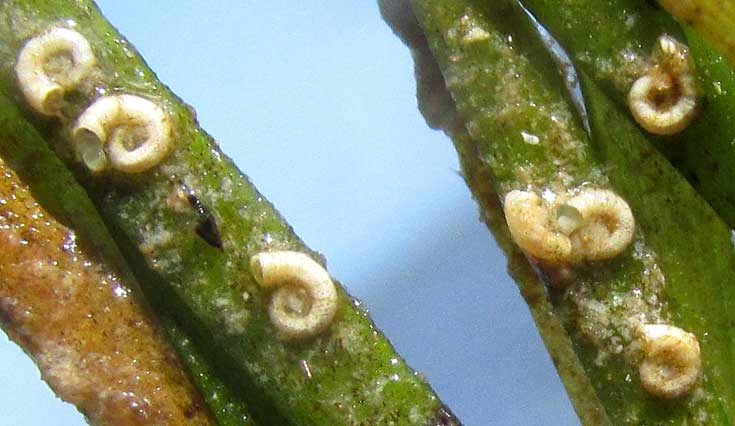Excerpts from Jim Conrad's
Naturalist Newsletter

from the December 14, 2014 Newsletter issued from Río Lagartos, on the Yucatan Peninsula's northern coast (~N21.60°, ~W88.16°), Yucatán state, MÉXICO
SPIRORBIS POLYCHAETES
Last week we looked at Shoalgrass, which forms large underwater prairies in the Ría Lagartos Estuary. Our Shoalgrass Page is at www.backyardnature.net/yucatan/shoal-gr.htm.
If you go to that page, on Shoalgrass leaves in the top picture you can see tiny, white dots of something stuck to the leaves' flat surfaces. A close-up of some of those white dots is shown above.
When I first saw those objects through my hand lens I thought they might be snail shells that somehow ended up with their sides stuck to the leaves. However, I'd never heard of snails doing anything like that, plus these were very small to be snails. Eventually I remembered seeing tiny calcareous shells attached to much larger oyster shells, on the Yucatan's Caribbean beaches, as shown at www.backyardnature.net/yucatan/shell-tb.htm.
Those tiny calcareous shells had been produced by a kind of segmented worm called a polychaete. A quick Google search for polychaetes occurring on Shoalgrass leaves turned up pictures looking just like ours.
Our Shoalgrass-attached polychaete belongs to the genus SPIRORBIS, but its species goes unnamed. The Spirorbis Page at the website of the Smithsonian Marine Station at Fort Pierce, Florida advises us that "Identification of any Spirorbis specimens to species level is difficult, even for trained taxonomists." That page with much information on the Spirorbis life cycle is at http://www.sms.si.edu/irlspec/Spirorbis_spp.htm.
Ecologically, Spirorbis species are described as "seagrass calcareous epibionts." The word calcareous describes something mostly or partly made of calcium carbonate (like limestone and the mineral calcite), while "epibionts" are organisms attached to and living on the surface of another organism. Spirorbis species are polychaete worms living in coiled shells their own bodies secrete. They are not mollusks, like snails, but are segmented worms, like earthworms. Mollusks and segmented worms are classified in completely different phyla.
Spirorbis species are filter-feeding animals who use a "crown" of stiff tentacles at the exposed ends of their shell-sheltered bodies to capture food particles from water circulating around them. In the above picture, notice that the Shoalgrass leaves appear to be coated with slime. Such slime is referred to as "microbial film," or "bio-organic film," and studies show that Spirorbis prefer to live on such microbial-film-covered surfaces.
While handling the Spirorbis-covered Shoalgrass leaves, I could feel shells shatter, despite my attempts to handle them carefully. In fact, studies find that Spirorbis shells offer only limited protection from predators such as fish who might nibble at them.
Still, with so many Spirorbis shells attached to each Shoalgrass leaf in a vast underwater seagrass prairie, the sheer numbers of Spirorbis individuals in the Ría Lagartos Estuary is mind boggling. Besides occurring on Shoalgrass they also attach to Manatee Grass and Turtlegrass, which dominate in seagrass prairies elsewhere. A study in Florida found their density in certain areas to reach 1600 individuals per square meter, a meter being a little longer than a yard. Here in the tropics perhaps they are even more abundant.